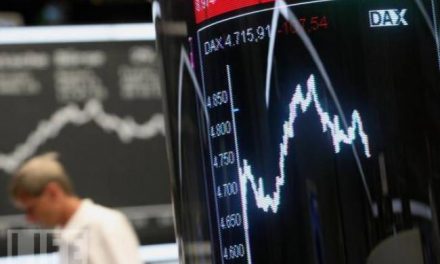By Mustafa Sonmez, Al-Monitor
On March 29, the Turkish Statistical Institute (TUIK) announced that the country’s gross domestic product grew 7.4% in 2017, the highest rate in the past four years.
The 7.4% rate made Turkey the second fastest-growing economy in the Organization for Economic Cooperation and Development after Ireland with 7.8% and ahead of Slovenia with 5%. The GDP, however, shrank in terms of dollars to $851 billion from $863 billion in 2016, reflecting the dramatic depreciation of the Turkish lira. Accordingly, GDP per capita went down to $10,597 from $10,883 in 2016.
There is another side of the coin, which shows that Turkey’s spectacular growth came thanks to government propping that is hard to sustain and at the expense of excessive borrowing and increasing fragilities. The social leg of growth is also troubling, as low-income Turks appear to have benefited little in terms of job opportunities and income increase.
As Deputy Prime Minister Mehmet Simsek conceded, government guarantees encouraging loan expansion were the main booster of growth, coupled with tax cuts and incentives. The economy’s growth was driven largely by domestic consumption, which brought about double-digit inflation — 12% in consumer prices at the end of 2017.
As the Turkish lira tumbled, the price of the dollar increased 21.7% last year, making Turkey’s imports more expensive. Coupled with the rise of global energy and commodity prices, this pushed up production costs at home, resulting in a 15% annual increase in producer prices. Hence, Turkey’s growth came at the expense of an unruly inflation.
The consumption-centered growth fueled imports, enlarging the country’s foreign-exchange gap. As a result, the current account deficit reached $47.1 billion or as much as 5.5% of GDP — a rate unique to Turkey.
Last year’s external debt stock is an important sign of how the economy relied on foreign funds to grow. Standing at $453.3 billion in official data, the external debt stock amounts to 53.3% of GDP and 70% of it belongs to the private sector.
So, a giant current account deficit and the hardship of sustaining external borrowing to grow are other troubling elements. Meanwhile, the government’s tax incentives — another stimulant of the growth — widened the gap in public finances, resulting in an alarming “twin deficit” together with the current account gap.
And did the growth contribute to job creation and a fair distribution of income? The unemployment rate remained unchanged at 10.9% from 2016 to 2017. Non-agricultural unemployment stagnated at 13%, while youth unemployment remained above 21%. In other words, the economic growth absorbed only the newcomers to the labor market and offered no hope to the already jobless. Overall, the number of jobless increased by 124,000 to reach 3.45 million in 2017.
When it comes to revenue distribution between employers and employees, the TUIK data shows that the trend developed to the detriment of the latter. Payments to labor stood at 34.5% of GDP, down from 36.5% in 2016, a clear sign that the 7.4% growth resulted in an unfair outcome for workers.
In another ironic development, the Turkish lira was in free fall in the hours when TUIK released the 7.4% growth rate, with the price of the dollar breaking the psychological barrier of four liras. Normally, economic growth on such a scale is expected to involve an influx of foreign investment and thus an abundance of dollars, leading the lira to appreciate. Yet, in March alone, the lira lost 5% of its value against the greenback, dissociating significantly from the currencies of other emerging economies. This in itself is a sign that Turkey’s economic growth has come with increasing fragilities and failed to inject confidence.
No wonder that Turkey’s five-year credit default swaps (CDS), known also as credit risk premiums, have risen to 203 basis points, the highest level since mid-November. Standing at 160 basis points in the beginning of the year, the CDS have been on the rise due to both foreign market developments and Turkey’s own economic and political risks.
The CDS increase reflects the higher pricing of Turkey’s risks and thus the rising interest rates it has to pay on its sovereign bonds. Neither the premium nor the interest rates can fall as long as the risks continue. The yield on Turkey’s 10-year bonds climbed close to 13% in March. It had hit 13.2% in November. The increase in the risk premium has owed also to a March 7 decision by credit rating agency Moody’s to cut Turkey’s sovereign rating further into junk territory, downgrading it to Ba2 from Ba1.
The depreciation of the lira appears bound to continue, chiefly because of Turkey’s external financing needs. Oil prices, meanwhile, are likely to rise during the year, which means the country’s current account deficit will continue to expand. The debt Turkey has to roll over in the next 12 months is close to $180 billion, which means it has to borrow between $220 billion and $230 billion in external funds, a sum amounting to more than 25% of GDP. As foreign capital flows to emerging economies decline, a burden of such a size will not be easy to manage, even though it will spread over 12 months. Moreover, the cost of borrowing is increasing. Given that reserves are not very strong, either, the pressure on exchange rates will continue.
Political uncertainty is the main reason foreign investors hesitate to put money in Turkey. A critical election cycle is looming in 2019, but a wait-and-see attitude prevails on financial markets because of the talk of early elections. This reason alone could prompt the government to bring the polls forward — to fall this year, for instance — to end the uncertainty.
If the slump of the lira continues, the central bank would be expected to intervene forcefully by hiking rates and/or using other monetary policy instruments. Absent an intervention, the rush for hard currency among domestic actors will push up foreign exchange prices even more, threatening further damage to the economy.



















